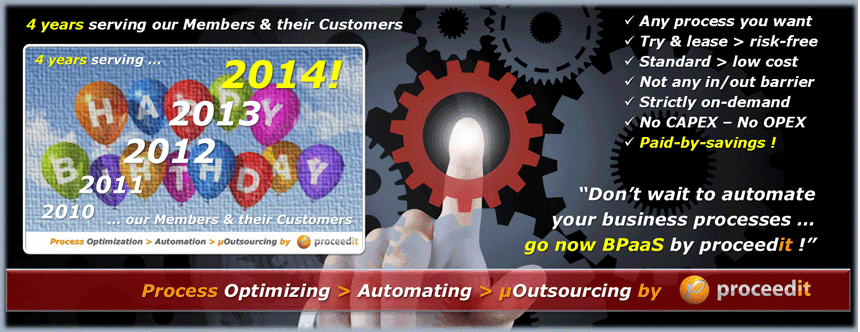As commented in
one of ours recent posts, by "BPM
Adoption" we understand the way that some organizations have
undertaken to relieve, optimize, automate and outsource part of their business
processes, with the ultimate aim of achieving and maintaining the Operational Excellence that ensure them
a sustainable competitive advantage.
To simplify our
analysis, we have grouped the various strategies of BPM Adoption usually followed by organizations in four archetypal
models, which we have called "Process
Team", "Cloud",
"Consulting" and "BPaaS".
Each model is
characterized by the decision organizations have made in terms of the Mode of Development of the automation
solutions, differentiating whether they do or plan to do by internal or
external means; and the Mode of Operation
of such automation solutions, differentiating if they do or plan to do either
on internal systems (on-premises) or
external (on Cloud or on an external Data Centre).
The “Consulting” model we analyze in this
post is similar to the “Process Team”BPM Adoption Model already analyzed
in a previous publication, but characterized by customers transferring the responsibility
of development to an external actor, the Consulting
Company.
Then, we
categorize under this “Consulting”
model to these organizations that choose the External Development Mode, by delegating this responsibility to an
external actor having a Business Consultancy, Implementer and/or Integrator
profile; and that applies the Internal
Exploitation Mode of the developed applications operating them on internal infrastructure
and platform resources, just as in the model "Process Team" mentioned above. This model is described in the
next figure:
In this “Consulting” model, the main external
actor o actors are the Consultant, Implementer and/or Integrator companies
contracted by the Client for the execution of the project and, the main project
vectors are the business knowledge and the technology skills that have one or
more of such companies.
Often the
project scope is split between more than one external companies, each of them
having specific profiles of the three methodology/technology specialties
required: business consultancy, Implementation of automation solutions on BPMS Platforms and integration of these
solutions with the corporate applications.
Risk and
responsibility for the development of the project are on the external company
(ies) side, although the Client follows the project very closely with its own business
and IT people.
Some BPMS vendors tread this ground to their
distributors (these ones usually called "partners"), making this
development work and implementation directly to their end customers, especially
when it comes to large companies or corporations or the BPMS vendors are small-mid size in the first stage of their
product/business development.
As consultancy
companies and, especially, implementers and integrators chosen by the customer
to perform the BPM project cannot
master all the 400+ BPMS technologies available, the market supplying BPM business consulting and technology
services is fragmented by BPMS Platforms.
The BPMS Platform on which to implement
automation solutions, is either selected by the customer and from this derive
the Consultant / Implanter chosen (either the same BPMS Vendor or one partner belonging to the BPMS Vendor ecosystem) or customer selects the Consultant/Implanter
and from this derives the BPMS Platform,
among the ones Consultant/Implanter is capable to support (usually no more than
two or three).
Under this BPM Adoption Model project costs are
very high and often extra-costs appears, either by insufficient prior
definition of the project, either by the difficulty of configuring these tools
or their functional weaknesses and, in large part, by changes on the initial
customer’s thoughts or new process improvement ideas that arise as a
consequence of the process optimization exercise done during the course of the
project.
Therefore, this
“Consulting” model has similar or even higher CAPEX (CAPital EXpenses)
and the same OPEX (OPerational EXpenses) than the “Process Team”BPM Adoption Model.
In this regard,
we believe that standardization and reusability of BPM automation solutions will
be critical issues in the future so that implantation and integration companies
could to be more competitive in their BPM
projects.


No comments:
Post a Comment